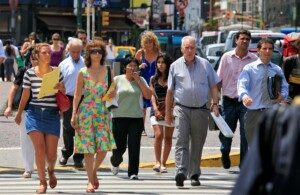Even though I’ve always felt like they were different from me, I’ve always found satisfaction in watching people go by.
Many Autistics like to watch people pass by, such as if the individual is eating outside at a café near a busy sidewalk.
Myself, along with two other autistic women, will describe why we enjoy watching people.
Now, to be fair, I don’t know how prevalent this favored activity is among Autistics vs. neurotypicals, but it comes up every so often in content posted by autistic people, such as in autism threads.
I’ve also seen this topic surface in autism checklists.
“I do like to watch people!” says Jennifer Parr, a multimedia artist.
“I usually do this from a distance and usually in a crowd-like situation so it’s not obvious I’m watching,” explains Jennifer, diagnosed with autism at 30.
“I feel this might be partially a safety thing for me to evaluate if anyone poses a threat to me, but I also just find people unique and interesting and like noting similarities and differences from myself.
“I suppose this helps me understand people better or to get a better understanding of certain people before I interact with them so I know what to expect.”
Jess Owen definitely enjoys watching people.
“I love people-watching, in the same way you might watch animals at the zoo,” says Jess, co-creator of thewyrdsisters.co.uk with her sisters and diagnosed with ASD at 25.
“I study how they behave, how they carry themselves and use their faces, how they interact with one another.
“I suppose this must be to learn from them, though it’s also a sort of pastime in itself.
“I find myself doing this mostly when I don’t have to worry about how I’m being viewed myself: from a car window, from the market stall where I used to work, from the corner of a bus stop, tucked away in the shadows.
“When I was a child I used to climb trees as high as I could, settle on a branch, and alternate between reading and studying the people below.
“I suppose it’s less of a social interaction when it’s so one-sided, less pressured (though perhaps also less socially acceptable). It’s useful and utterly fascinating.”
I had always found it odd that I like to watch people go by, even though I’ve always “disliked” people.
I don’t deliberately dedicate time to just sit idly and observe people.
Instead, if I know I’m going to be waiting somewhere or stationary for a while, I’ll choose a location where I can watch humanity walk past me.
Does this please me because I’m autistic?
I don’t know. I’m sure there are NTs who’ll do the same thing.
A good example is that I like to use an end treadmill at a given gym, because usually, an end treadmill is situated where gym members walk by – such as fairly close to the front desk.
While on the machine I can then watch people entering the gym and checking in at the desk, and people exiting. Sometimes two or three are near the desk chatting. I’ll watch!
Of course, I don’t keep staring as they’re coming my way. I’m discreet and glance away as they begin in my direction.
But I get a good look at them while they’re entering and while they’re at the desk.
One might say that this gives my mind something interesting to do while using a treadmill.
But I’ll also enjoy watching people anyplace where I have to sit for a while, such as at an airport.
My autism may also be why a lot of thoughts and what would be considered analysis go through my mind upon observing certain people.
For example, there’s this man whom I’ve seen several times now come into the gym who wears shorts in warm weather, revealing very thick, edematous, sickly looking legs that are purplish red at the lower half – an indicator of venous insufficiency.
He uses a cane and is obese, so all these visible observations paint the picture of a very unhealthy man.
My mind will launch into how this man, who appears to be in his 50s, possibly 60s, probably fiercely regrets never having taken up serious workouts when younger, which would’ve helped immensely with weight control and likely prevented whatever’s going on in his legs.
I then begin thinking about venous insufficiency, cardiovascular disease, stroke – all the things that a hardcore workout regimen goes a super long way at helping to prevent.
I like to observe peoples’ hair. I’m always hoping to see a huge, voluminous ponytail.
Wild mops of hair also get my attention, as does racial ambiguity, being that I’ve always had a fascination with the appearance of mixed race.
I’ll find myself wondering what the precise racial breakdown is in, for instance, that very light skinned man with the dark tight coils of hair sprouting from his head in all directions, or the woman with light golden/creamy thick skin and sandy brown but vaguely kinky hair.
And if any of this sounds odd, strange or busybody-ish, remember: I’M AUTISTIC – clinically diagnosed and damn proud of it.
In a nutshell, the reason I like to observe people while I’m in one spot is perhaps because I’ve always been fascinated by human psychology.
Maybe it’s because I’ve always been into physical fitness and can appreciate the very occasional really fit-looking body when I’m out and about in public.
Maybe it’s because….well gee, I just like to and can’t really put my finger on it.
How much of any of this ties to autism is left up to the imagination.
I’ve read of cases where other autistic individuals watch people in an attempt to figure them out.
I will be posting quoted statements from clinically diagnosed Autistics as to why, for them, watching people walk by is a satisfying, enjoyable or intriguing activity.
Certainly, there are many reasons that other autistic people do this – reasons that I may not have even considered. I really look forward to adding their voices to this post!
 Jennifer Parr has always had a devoted obsession to art and creativity. Her ultimate goal is to help others discover their own creative side and find enjoyment through art and crafting.
Jennifer Parr has always had a devoted obsession to art and creativity. Her ultimate goal is to help others discover their own creative side and find enjoyment through art and crafting.
 Jess Owen, along with her sisters Emily and Abi, run thewyrdsisters.co.uk, about autistic sisters navigating a neurotypical world. Their goal is to spread information and awareness, and open up a conversation about neurodiversity that will make life easier for everyone.
Jess Owen, along with her sisters Emily and Abi, run thewyrdsisters.co.uk, about autistic sisters navigating a neurotypical world. Their goal is to spread information and awareness, and open up a conversation about neurodiversity that will make life easier for everyone.
 Lorra Garrick has been covering medical and fitness topics for many years, having written thousands of articles for print magazines and websites, including as a ghostwriter. She’s also a former ACE-certified personal trainer. In 2022 she received a diagnosis of Level 1 Autism Spectrum Disorder.
Lorra Garrick has been covering medical and fitness topics for many years, having written thousands of articles for print magazines and websites, including as a ghostwriter. She’s also a former ACE-certified personal trainer. In 2022 she received a diagnosis of Level 1 Autism Spectrum Disorder.
.



























